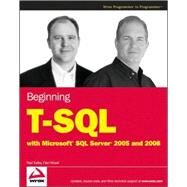- ISBN: 9780470257036 | 0470257032
- Cover: Paperback
- Copyright: 12/1/2008
Transact-SQL, or T-SQL, is Microsoft Corporationrs"s powerful implementation of the ANSI standard SQL database query language, which was designed to retrieve, manipulate, and add data to relational database management systems (RDBMS).You may already have a basic idea of what SQL is used for, but you may not have a good understanding of the concepts behind relational databases and the purpose of SQL. This book will help you build a solid foundation of understanding, beginning with core relational database concepts and continuing to reinforce those concepts with real-world T-SQL query applications.If you are familiar with relational database concepts but are new to Microsoft SQL Server or the T-SQL language, this book will teach you the basics from the ground up. If yours"re familiar with earlier versions of SQL Server, it will get you up-to-speed on the newest features. And if you know SQL Server 2005, yours"ll learn about some exciting new capabilities in SQL Server 2008.Information Technology professionals in many different roles use T-SQL. Our goal is to provide a guide and a reference for IT pros across the spectrum of operational database solution design, database application development, and reporting and business intelligence solutions.Database solution designers will find this book to be a thorough introduction and comprehensive reference for all aspects of database modeling, design, object management, query design, and advanced query concepts.Application developers who write code to manage and consume SQL Server data will benefit from our thorough coverage of basic data management and simple and advanced query design. Several examples of ready-to-use code are provided to get you started and to continue to support applications with embedded T-SQL queries.Report designers will find this book to be a go-to reference for report query design. You will build on a thorough introduction to basic query concepts and learn to write efficient queries to support business reports and advanced analytics.Finally, database administrators who are new to SQL Server will find this book to be an all-inclusive introduction and reference of mainstream topics. This can assist you as you support the efforts of other team members. Beyond the basics of database object management and security concepts, we recommend Beginning SQL Server 2005 Administration and Beginning SQL Server 2008 Administration from Wrox, co-authored in part by the same authors.This book introduces the T-SQL language and its many uses, and serves as a comprehensive guide at a beginner through intermediate level. Our goal in writing this book was to cover all the basics thoroughly and to cover the most common applications of T-SQL at a deeper level. Depending on your role and skill level, this book will serve as a companion to the other Wrox books in the Microsoft SQL Server Beginning and Professional series..This book will help you to learn:How T-SQL provides you with the means to create tools for managing databases of different size, scope, and purposeVarious programming techniques that use views, user-defined functions, and stored proceduresWays to optimize query performanceHow to create databases that will be an essential foundation to applications you develop laterEach section of this book organizes topics into logical groups so the book can be read cover-to-cover or can be used as a reference guide for specific topics.We start with an introduction to the T-SQL language and data management systems, and then continue with the SQL Server product fundamentals. This first section teaches the essentials of the SQL Server product architecture and relational database design principles. This section (Chapters 13) concludes with an introduction to the SQL Server administrator and developer t







